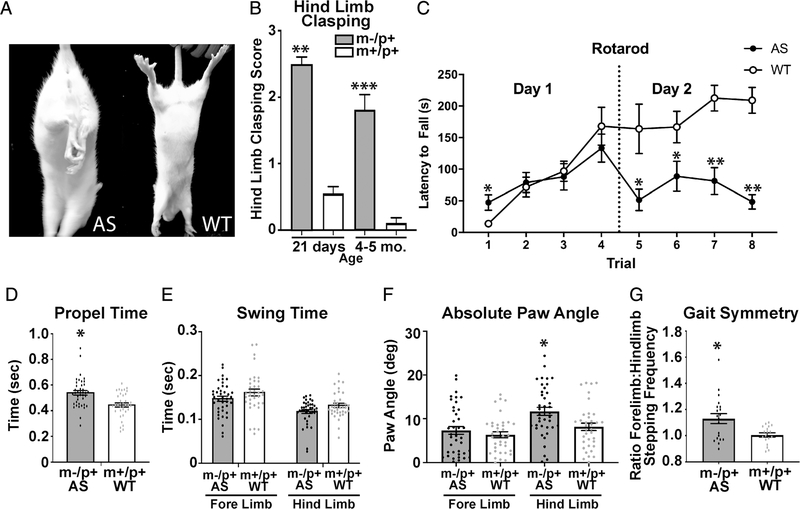Figure 3.
AS rats exhibit hind limb clasping and alterations in gait. (A) Representative limb postures following tail suspension in both AS and WT rats (4 weeks post-natal). (B) AS (21 days n = 69 (30F, 39M), 4–5 months n = 16 (8F, 8M)) display a significant increase in hind limb clasping compared to WT (21 days, n = 90 (45F, 45M), 4–5 months n = 11 (8F, 10M)) (21 days, t(157) = 13.03, *P < 0.001, 4–5 months, t (32) = 7.43, p < 0.0001). (C) AS rats display decreased latency to fall off of rotating rod (n = 10) during trials 1, 5, 6, 7, and 8. (AS n =10 (5M, 5F), WT n =10(5M,5F); F(7,126) = 9.989, P < 0.0005. (D) AS rats display decreased hind limb propel time (time required for accelerating the motion and continuing the forward motion) when compared to WT littermate controls (AS n = 20 (11F, 9M), WT n =18 (8F, 10M); t(74) = 3.908, *P < 0.0005). (E) There are no significant differences between groups in swing time (time duration of swinging the paw without belt contact; Swing fore-limb t(74) = 1.455, P > 0.05; Swing hind-limb t(74) = 2.13, P > 0.05). (F) Significant differences were observed between groups in paw angle (absolute degree of paw angle) (paw angle fore-limb t(74) = 0.865, P > 0.05; paw angle hind-limb t(74) = 2.217, P < 0.007). (G) AS rats display an alteration in gait symmetry when compared to WT littermate controls (t(36) = 2.919, P < 0.007) (gait symmetry: ratio of fore limb stepping frequency to hind limb stepping frequency). All outliers that were excluded from analysis (greater than 2 standard deviations from mean) are indicated by a square rather than a circle.

